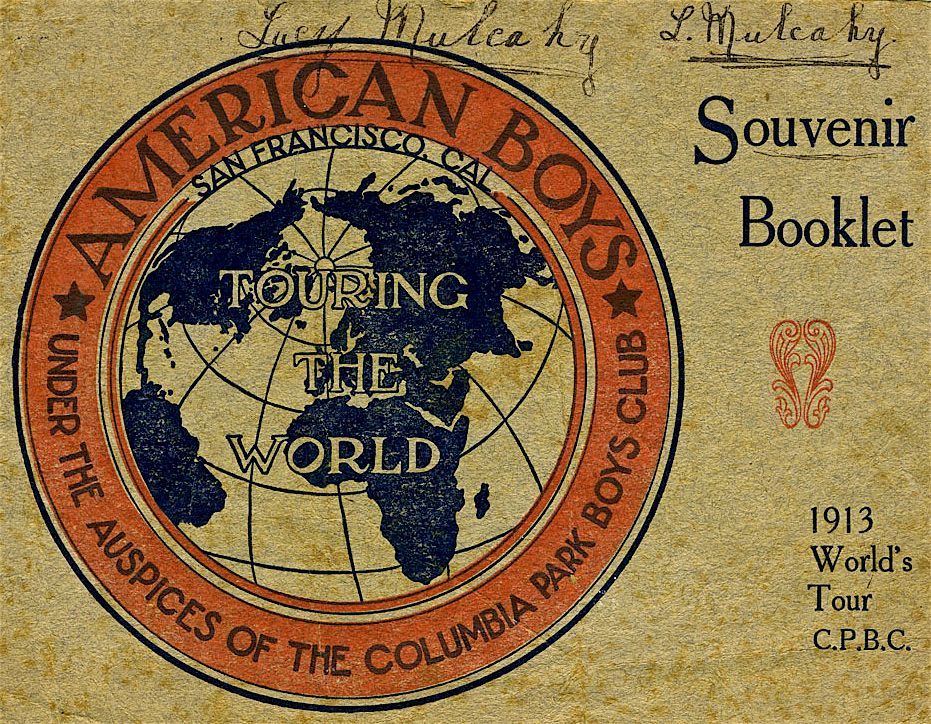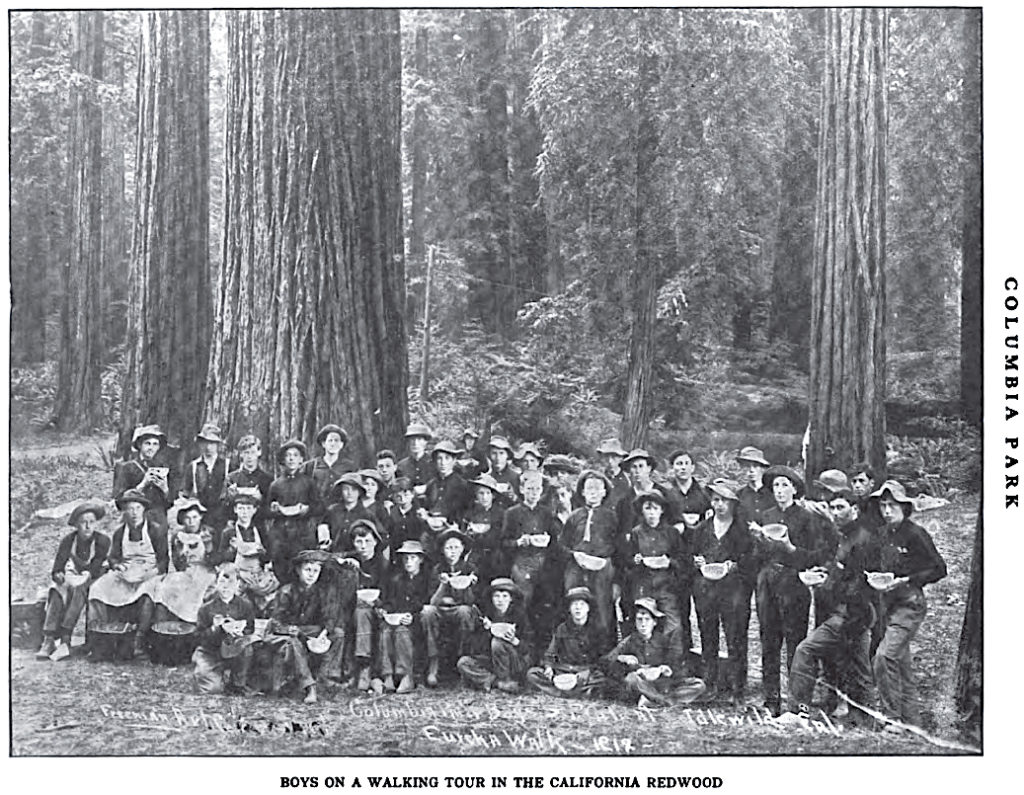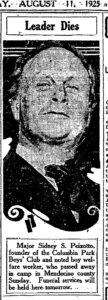“I realized that what they needed more than anything else was association and training, and vigorous methods by which they would be dragged from their comatose state and unhealthful and narrow surroundings into an atmosphere of vigor and life and uplifting influences.” -Major Sidney S. Poixotto, Founder, Columbia Park Boys’ Club of San Francisco
As fate would have it a few years ago, I was reading through vintage physical culture journals that had been long forgotten when I ran across the most bizarre story about a boys club that had the boys hiking for dozens of miles one way just for fun. From San Francisco, the boys would walk to Monterey, Yosemite, and even to Los Angeles (500-600 miles) during summer vacation months! Walking! The boys would average 15-20 miles per day, set up their own camp, do their own cooking, then perform for local audiences with their band and acrobatics to raise their own travel money.
This amazing group was called the Columbia Park Boys’ Club of San Francisco. I learned that the CPBC was world-famous and actually toured the nation and globe performing with their band and acrobatic acts. Even more impressive? These boys were the street thugs of their era–juvenile delinquents aged 8-17 who were coaxed off the streets in the section south of the Market Street tenement area known as “South of the Slot” which was dominated by the “Rincon Hill Gang. These ruffian boys were then taught how to behave and elevate culture. Many of these street delinquents that went through the CPBC experience went on to become community leaders and outstanding citizens. What was their secret?
The CPBC was founded in December 1895 by Major Sidney S. Peixotto (pay-SHOW-toh). The CPBC eventually built its own facility in 1908 at 450 Guerrero Street between 16th and 17th streets in San Francisco. The club’s original location before the great fire was 118 Seventh Street. The Peixotto family was a very prominent Jewish immigrant family in the San Francisco bay area and in the United States. Sidney’s aunt was Dr. Jessica Peixotto who was the first female full professor at UC Berkeley where she taught social economics. Brother Ernest C. Peixotto was a well-known artist. Brother Eustace M. Peixotto was a Captain in the US Army. Another brother Edgar D. Peixotto was a prominent San Francisco attorney and former district attorney of San Francisco. Earlier generations of Peixottos were prominent in medicine and business too. There is also a “Poixetto Playground” and park in San Francisco named after this notable family.
“It is well recognized that one of the best means of strengthening moral character in a boy is to build up a sound body.” -Victor L. O’Brien, “The Columbia Park Boy’s Club of San Francisco”
So how did Major Peixotto create a world-famous boys’ club out of juvenile delinquents? While there are numerous points to the story, here are the major areas to discuss and contemplate. I’ve linked numerous references below for further investigation–one article was written by Sidney Poixotto. In brief, the success of CPBC can be attributed to making well-rounded boys, or what Major Poixotto called, “All-Round Boys.” The Major also had a unique way of giving the boys what they really wanted and developing them as they expanded their interests in new areas. These approaches took the CPBC from a few street hoodlums to the top youth in the area wanting membership…and the rest is history. 🙂
“It’s cheaper to build boys than to mend men.” -Major Sidney S. Poixotto
- “STRONG WORK” was Major Poixetto’s motto for the CPBC. More specifically, it was individual work because every single boy in the program worked to make the money needed to run the boys’ club. While there were no club membership fees as everything was provided, everyone also worked and contributed; there were no free rides or giveaways. Contribution to the group was mandated by ALL–NO exceptions. The boys earned what they could with the remaining expenses covered by donations. Everything was FREE–but came through hard work contributions by the boys themselves. This philosophy is very similar to tribal cultures where everyone contributed to the group from young to old–everyone had a job to do and did it.
- BEAUTY: The boys were taught to see the beauty in everything around them. This taught them a level of sophistication instead of their normal street crudeness.
- QUALITY: Everything about the CPBC was first class from the writing instruments to the band uniforms. Major Poixetto believed in teaching the boys to recognize quality and respecting the equipment and program materials.
- PHYSICAL CULTURE: The CPBC used a classical physical education design that also included acrobatics and athletic sports. They had a dedicated physical education instructor. The physical culture was central to their success as a way to strengthening the moral character of the boys.
- EDUCATION: All the work given to the boys was presented in the “simplest possible methods.”
- MUSIC & BAND: The CPBC band was world-famous and even won the California State Fair beating out adult military bands. At one point, the CPBC had a 72-piece military band with a drum and bugle corps of 28. Interestingly, the CPBC did not follow the traditional music training methods to drill and practice fundamentals and scales, but rather, they allowed the boys to create self-mastery through experimental play–the focus was on learning not the regimentation of fundamentals.
- THEATRE ARTS: CPBC had quite a theatre focus that went from local small plays to performing for heads of state around the world.
- MANUAL ARTS/HANDICRAFTS: There was great attention to hand skills through manual arts at the CPBC. Historical education cites the importance of hand skills for the development of the brain and cognitive function. If you want to develop the best thinkers–develop the best hand skills through manual arts.
- GROUPING: Poixetto did an amazing job breaking the boys into smaller groups and subgroups. This was a primary management strategy for him as the boys learned the values of “self-governing” and self-control and ownership of their programs and behaviors.
- HIGH STANDARDS: The CPBC took low achievement boys that had not been pushed for excellence and raised their standards for high morale behavior and high-level performance in music and physical activities. Poxietto did NOT lower the bar–he raised it and with the proper support and belief in the boys getting the job done. It worked. This philosophy of reaching for something better is in alignment with the Greek Arete’ which translates as “striving for excellence.” To ancient Greeks, no man is perfect as a human, but it is our duty to “strive for excellence” as we “reach for higher goals and achievements.”
- OUTDOOR RE-CREATION: A major part of the CPBC building up the character and morale of boys was their emphasis upon hiking, camping, and nature walks–some of which were quite lengthy covering many weeks.
- TRAVEL & EDUCATION: Major Poixotto was an early advocate of “education by travel.” It started with his local walking trips then expanded to national and international trips including full-year excursions where the boys traveled, learned, and performed all over the US and world for heads of state and the intelligentsia.
To summarize and condense as well as learn from history, it appears after years of research on Major Poixetto and his Columbia Park Boys’ Club that there were a few key components. First, he taught the boys to see and appreciate beauty. This is a radically different approach than how many juvenile delinquent boys are treated today in America. How would today’s problem boys behave if someone brought them the best instead of the worse or substandard? He also taught the boys to be well-rounded. Poixetto cited the boys coming off the street as too “one-sided” and focused on just one sport or one thing. He opened up their worlds to different things and always with an attention to the details of beauty. These expansions included regular education plus arts, hobbies, athletics, PE, combatives for self-defense, theatre, band and music, manual arts, outdoor recreation, museums, and extensive travel not only in the region but also nationally and even internationally. During 1913Physical culture was prominent throughout. The best way to build strong minds and great citizens is through the physical; this philosophy goes all the way back to ancient Greece and “mens sano in corpore sano” or “sound mind in sound body.” Poixetto was also a master at looking at what the individual boy needed which is not easy to do with a large group of rambunctious street delinquents. So, the Columbia Park Boys’ Club was truly something special and quite legendary as was their noble founder and leader Major Sidney S. Poixotto.
In my opinion as a history scholar, credentialed teacher, parent, grandparent, and concerned American citizen–we should be studying the legacy of the CPBC and implementing many of their building blocks of success again…and the sooner the better.
*I’ve collected several articles on the CPBC over the last few years that I will share below. There was only one book written on the CPBC entitled, “The Major And His Boys: The Story of Major Sidney Peixotto and the Columbia Park Boys’ Club.” It was published in 1972 by former CPBC member James M. Hamill.
References:
- “The Major And His Boys: The Story of Major Sidney Peixotto and the Columbia Park Boys’ Club” by James M. Hamill (1972)
- “Sixth Walking Tour. Columbia Park Boys to Go to Eureka in the Near Future” (SF Chronicle, June 6, 1903)
- “Columbia Park Boys’ Club: San Francisco Lads Touring United States Will Perform in New York” (NY Times, March 12, 1911)
- “To Yosemite Valley Via Vaudeville: How the Columbia Park Boys’ Club of San Francisco Goes on a Vacation” by William Alfred Corey (Boys’ Life Magazine, 1913)
- “The Columbia Park Boys’ Club of San Francisco” by Victor L. O’Brien (The American Journal of Sociology, Vol. 7, Sept. 1, 1901)
- “The Columbia Park Boys’ Club, A Unique Playground” by Eustace M. Peixotto (The Annals of the American Academy of Political and Social Science, Vol. 35, No. 2, Public Recreation Facilities, Mar. 1910, pp. 220-224)
- “Making the All-Around Boy: The Story of the Columbia Park Boys’ Club” by Sidney S. Peixotto (Sunset Magazine, Vol. XXV, July 1910, pp. 99-103)
- “The Columbia Park Boys, of San Francisco” (WORK WITH BOYS: A Magazine of Methods, Vol. XV, 1915)
- Columbia Park Boys’ Club Photos (Good Old Sandlot Days)
- ArchiveGrid: Columbia Park Boys’ Club (UC Berekely)
Media Appearances by Ron Jones on CPBC History:
- “San Francisco Exposed” with Clint Griess (Podcast)
- “San Francisco Exposed” with Clint Griess (YouTube)
Sidney S. Peixotto: (1866-1925)
- Founder, Columbia Park Boys’ Club (1894)
- Founder, Public Schools Athletic League (1908)
- President, Pacific Athletic Association of the American Amateur Athletic Union
- Major, California National Guard (1903)
- Obituary (San Francisco Chronicle, August 1, 1925)
- Peixotto Playground & Park of San Francisco
- The Peixotto Family (The Knowles Collection)
- Columbia Park Clubhouse (Current Version is Boys & Girls Club Clubhouse)
I truly hope this important history inspires people to do a better job with guiding our current youth because they surely need more than a smartphone and mindless amusements to navigate successful and joyful lives.
–Ron Jones, MS, Historical Kinesiologist, Physical & Health Educator
#columbiaparkboysclub


